Articles
It was a busy summer for the United States and Japan. President Joe Biden visited Asia, stopping first in Seoul to meet new South Korean President Yoon Suk Yeol, and then spending two days in Tokyo for a bilateral summit with Prime Minister Kishida Fumio and a follow-on meeting with the two other leaders of the Quad, Indian Prime Minister Narendra Modi and Australia’s newly elected prime minister, Anthony Albanese. Biden announced his Indo-Pacific Economic Framework in Tokyo with Kishida by his side. Economic security legislation in both Japan and the United States revealed the unfolding strategic calculations for the alliance. National efforts to enhance economic productivity and resilience included efforts to ensure reliable supply chains for Japanese and US manufacturers as well as the desire for greater cooperation among the advanced industrial economies to dominate the next generation of technological innovation. State investment in attracting semiconductor suppliers to Japan and the United States demonstrate the urgency with which both governments seek to diminish reliance on critical technology imports.
Despite all the diplomatic planning that accompanied these developments, the summer was not without surprises. In Japan, the sudden death of former Prime Minister Abe Shinzo, at the hand of a lone gunman, shocked a nation known for its relatively low rate of gun violence. Across the globe, leaders praised Abe’s statesmanship and his strategic vision—his ability to meet Japan’s moment of challenge as the rules-based order was under threat.
Only weeks later, the United States and China found themselves in a high-stakes military standoff over Taiwan. US Speaker of the House Nancy Pelosi rescheduled her Asia tour after having to cancel it in April due to COVID-19. Her itinerary leaked, and her intention to visit Taiwan drew China’s ire. A top commentator for the Global Times tweeted that China’s People Liberation Army (PLA) had the right to shoot down Pelosi’s plane if she did. And a highly charged demonstration of Chinese military power ensued. The PLA exercises conducted after her departure directly involved Japan as missiles landed in its exclusive economic zone (EEZ). The United States ensured that its military was close at hand to dissuade miscalculation.
Biden Visits Asia
The visit of President Joe Biden to Asia had been much anticipated. Biden’s first stop was in Seoul, where he met with President Yoon Suk Yeol, who had only been in office for 11 days. The remainder of Biden’s time in Asia was spent in Japan. Prime Minister Kishida greeted Biden in Tokyo for their first in-person meeting, and the two leaders spent much of their time discussing a considerable range of issues related to their bilateral alliance.
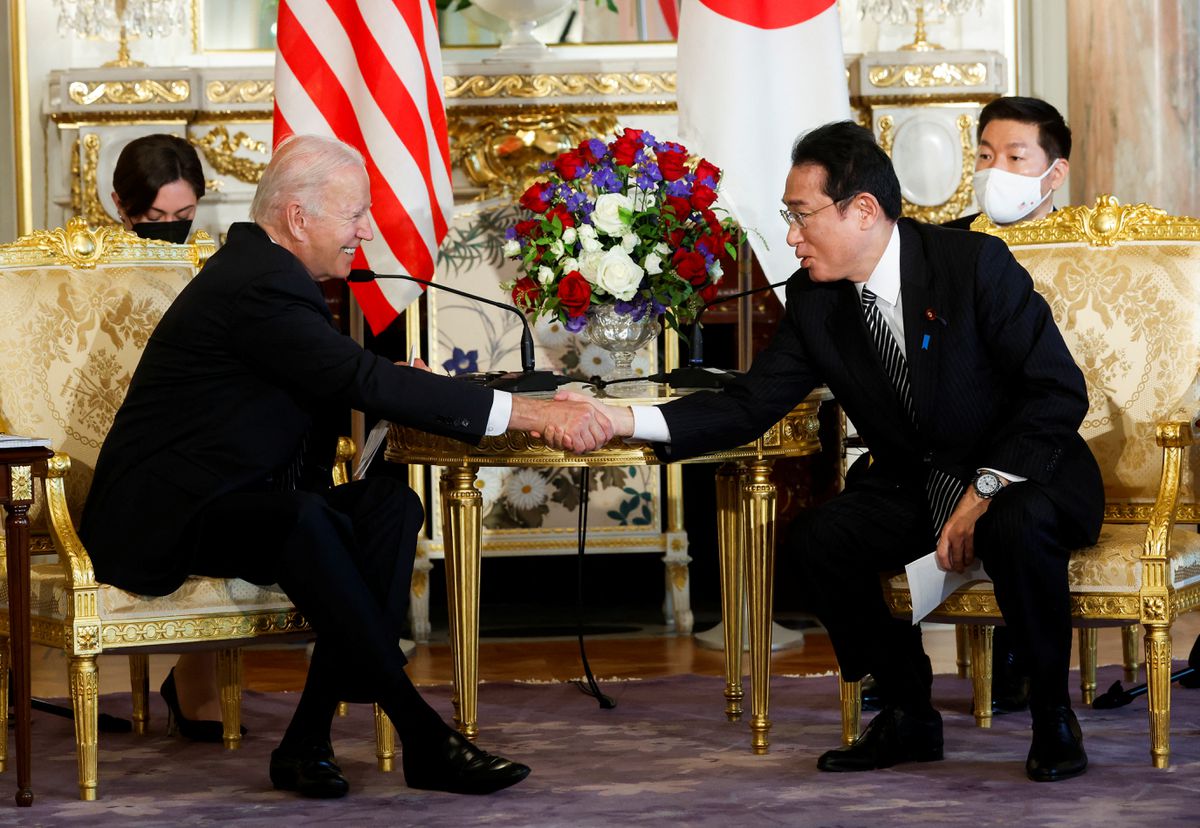
Figure 1 US President Joe Biden and Japanese Prime Minister Kishida Fumio shake hands as they attend a bilateral meeting at Akasaka Palace in Tokyo, Japan, May 23, 2022. Photo: Jonathan Ernst/Reuters
The Russian invasion of Ukraine and the tensions across the Taiwan Strait provided two focal points. In their joint statement, Biden and Kishida referred to Russia’s “brutal, unprovoked, and unjustified aggression against Ukraine” as the “greatest immediate challenge” to international law and order. The two leaders reaffirmed their commitment to providing support for Ukraine and imposing punishing sanctions against Russia. They also discussed the potentially far-reaching implications of the Ukraine crisis for the Indo-Pacific region. For instance, Biden and Kishida noted the recent joint military exercises by China and Russia, and reiterated that they “strongly oppose” any attempt by either country to change the status quo by force.
While the joint statement did not directly tackle how the United States and Japan would cooperate should a crisis emerge across the Taiwan Strait, the press conference held after their meetings produced a clear signal from Biden on how he thought about the US role. When Biden was asked by a reporter if the United States would be willing to use force to defend Taiwan, Biden unequivocally said, “yes.” This became the headline for the bilateral visit even though there were other quotes from that press conference that could have been headlines. Kishida, for example, made it expressly clear that his Cabinet would increase Japan’s defense spending within the next five years to a level equivalent to the NATO target of 2% of GDP. He also clearly stated that his government was considering the acquisition of its own (albeit conventional) retaliatory capability.
Tokyo has long expressed its desire to see Washington return to an economic leadership role in Asia. The Biden administration’s new Indo-Pacific Economic Framework (IPEF) was thus announced during this visit. The ASEAN Leaders Summit held the week before in Washington provided ample opportunity for the Biden administration to garner regional support. When, alongside Kishida, Biden announced the IPEF, he could claim a dozen Indo-Pacific nations had signed on to his new economic initiative—Australia, Brunei, India, Indonesia, Japan, Korea, Malaysia, New Zealand, the Philippines, Singapore, Thailand, and Vietnam—which together represent 40% of the world’s GDP. Four pillars constitute the aims of the IPEF: trade; supply chains; clean energy, decarbonization, and infrastructure; and effective tax, anti-money laundering, and anti-bribery regimes.
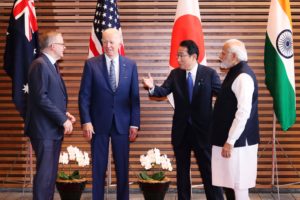
Figure 2 Leaders of the Quad meet in Tokyo, May 24, 2022. Photo: Prime Minister’s Office of Japan
The last meeting for President Biden in Tokyo was with leaders of the Quad. Hosted by Japan, this summit brought together the leaders of the United States, India, and Australia to continue their effort to define the principles that should underpin the Indo-Pacific region: freedom of navigation, peaceful resolution of disputes, and a rules-based approach to regional problem-solving. This meeting was ambitious, announcing what had already been accomplished since they came together in early 2021 on COVID relief as well as two new initiatives to develop Quad cooperation. First, a new fellowship in STEM for younger members of Quad countries to build the next generation of leadership. Second, the Quad leaders announced the creation of the Indo-Pacific Partnership for Maritime Domain Awareness, a significant effort to contribute technology and expertise to ensure oversight and lawful activity in the region. The list of shared Quad projects was long, including cooperation in space, on climate change, and on a host of economic resiliency goals.
Domestic political change in Japan and Australia has not dimmed their leaders’ enthusiasm for the Quad, and the mood in Tokyo was optimistic and demonstrably warm. India’s unwillingness to join in condemning Russia had not altered the other members’ enthusiasm for the summit. But it was obvious that Russia and China are unsettled by the Quad. On May 18, China’s Foreign Minister Wang Yi cautioned his Japanese counterpart, Foreign Minister Hayashi Yoshimasa, not to be drawn into the US strategy in ways that could “undermine China’s sovereignty, security, and development interests.” On the day of the Quad gathering, Chinese and Russian strategic bombers together circled the Japanese islands to communicate their displeasure.
The Economic 2+2
On May 11, Japan’s Upper House passed a new law for promoting economic security. Despite the approaching Upper House election in July, the bill faced little opposition in the Diet. The legislation had been a priority for Kishida, who last October announced the creation of a new Economic Security Minister in his Cabinet. He appointed Kobayashi Takayuki to the post. As Kobayashi shepherded the legislation through the Diet, he made sure to incorporate advice from the private sector and Japan’s major business associations, the Keidanren and Keizai Doyukai. The final law, like the US-led IPEF that followed it, is defined by four pillars: supply chains; security of basic infrastructure; public-private sector research into innovation and technology development; and classifying patents to protect critical technologies. The law provides a mandate for government action, though it will ultimately be up to various ministries to turn these goals into concrete executive actions over the next several years.
The Biden administration too began to pursue a legislative agenda that would strengthen US competitiveness. On Aug. 9, Biden signed into law the CHIPS and Science Act of 2022, which seeks to strengthen US supply chains and economic security. The law sets aside $52 billion in tax credits and subsidies to help grow chip manufacturing in the United States, as well as more than $200 billion toward research in areas such as artificial intelligence.
The United States and Japan will coordinate economic security policies through the newly established US-Japan Economic Policy Consultative Committee (i.e., the “Economic 2+2”). First announced back in January as a counterpart to the 2+2 meetings between US and Japanese defense and foreign ministers, the Economic 2+2 convened on July 29 in Washington. Japan’s delegation was led by Foreign Minister Hayashi and METI Minister Hagiuda Koichi, who met with their US hosts Secretary of State Antony Blinken and Secretary of Commerce Gina Raimondo.
The Economic 2+2 meeting laid out an action plan for the alliance. Acknowledging that “recovery from the COVID-19 pandemic remains incomplete,” the two sides nevertheless pledged to present a “positive economic vision that highlights the benefits of a rules-based international economic order.” In doing so, they highlighted a shared commitment to addressing challenges such as supply chain resilience, joint R&D on critical and emerging technologies, and countering attempts by third parties at economic coercion.
The Shocking Death of Abe Shinzo
On July 8, while campaigning for candidates in the Upper House election, former Prime Minister Abe Shinzo was shot by a lone gunman. The assailant, Yamagami Tetsuya, it was later revealed, had a personal grievance against Abe related to his mother’s association with the Unification Church (whose official name is the Family Federation for World Peace and Unification). Abe’s grandfather, former Prime Minister Kishi Nobosuke, had been responsible for supporting the establishment of the Korean mass-based new religion in Japan, and Abe like many other conservative politicians had spoken at their gatherings in recent years.
Abe’s murder raised serious questions about public safety in Japan. In a nation with a remarkably successful policy on restricting access to guns, Abe’s death by gunshot was a deep shock. In 2021, only 10 cases of gun violence had been recorded by the country’s National Policy Agency. Guns are typically associated with violence between groups of organized crime, but this gun had been handmade. In addition, the failure of the police to protect Abe revealed flaws in state security planning. A subsequent review by the National Policy Agency held both national and local police responsible for a failure to coordinate, and the National Policy Agency chief resigned as a result.
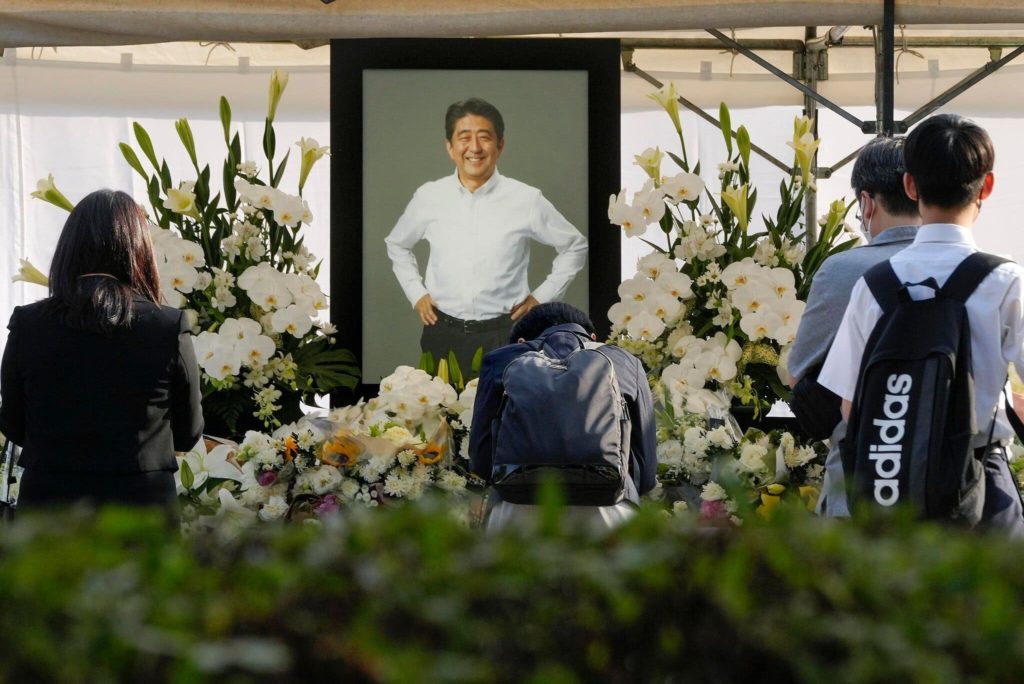
Figure 3 A public tribute to Abe Shinzo, Japan’s longest-serving prime minister. Photo: Kimimasa Mayama/EPA via Shutterstock
This violence came only two days before national elections for the Upper House. Prime Minister Kishida halted campaigning on the day of Abe’s death, but a day later on Saturday, Japan’s politicians were back on the campaign trail for a final day. Kishida called the attack a “cowardly and barbaric act committed in the middle of an election, which is the basis of democracy.” Despite Kishida’s worry that the violence would deter Japanese voters, the Upper House election on July 10 occurred without incident. Voter turnout was roughly as expected, suggesting that Abe’s death did not have a huge impact on electoral outcomes.
As predicted, the Upper House results were a win for a somber LDP, and bolstered Kishida’s leadership of the party. The LDP won 63 seats, giving the party and its coalition partner Komeito a majority in the chamber with control of 146 of 248 seats. Opposition parties fared badly, with a setback for the Constitutional Democratic Party of Japan with a loss of 6 seats, bringing their total to 39 seats. The Osaka regional-based party, Ishin, fared better and increased its seat share by 5 to 21 seats. But unlike in the Lower House election of 2021, the opposition parties did not craft an electoral coalition and thus presented a divided front at the polls. Japan’s economy seemed to be utmost in the minds of voters as inflation rose and the conflict in Ukraine shook the global economy.
The most striking political impact of Abe’s death may be within the LDP itself. As head of the party’s largest faction, with over 90 members, Abe held considerable sway over the party platform, and it was anticipated over the future leadership of the country. His faction has yet to name a successor and instead has chosen collective leadership with Shionoya Ryu and Hakubun Shimomura at the helm.
Kishida was attentive to these dynamics as he reshuffled his Cabinet on Aug. 10. Hoping to unify the party, Kishida was careful to consult with all factions and appoint a Cabinet that showed the unity of the party. Members who retained their posts included Chief Cabinet Secretary Matsuno Hirokazu, Foreign Minister Hayashi, and Finance Minister Suzuki Shunichi. Kishida brought Takaichi Sanae into the Cabinet as Minister for Economic Security and Kono Taro as Digital Minister. Party leadership positions also reflected Kishida’s desire for unity. Secretary General Motegi Toshimitsu remained, but new faces emerged as METI Minister Hagiuda was appointed chairman of the Policy Research Council and election chief Endo Toshiaki became chairman of the General Council.
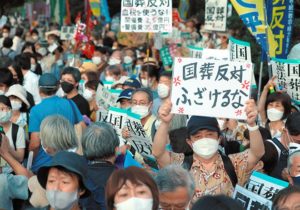
Figure 4 Protesters in front of the Diet building in Tokyo on Aug. 31, 2022 demand the government drop its plan to hold a state funeral for former Prime Minister Abe Shinzo. Photo: Tetsuro Takehana/Asahi Shimbun
This fresh start for Kishida, however, has not improved his support ratings. Two issues have stimulated public disapproval in the wake of Abe’s death. First, Kishida’s decision to host a state funeral for Abe has prompted considerable opposition within Japan. Slated for Sept. 27, the Japanese media report that over half of the public are against this use of public funds. Demonstrators gathered outside the Kantei to scold Kishida for his effort to honor publicly the former prime minister.
Second, and perhaps more damaging to the LDP, the public has been deeply concerned about the way Japan’s politicians have encouraged the Unification Church over the years. According to Abe’s murderer, his mother had been convinced by the church in the wake of his father’s death to donate most of the family’s assets to the group, a practice that many in Japan see as part of the Unification Church’s predatory practices. Despite complaints to the government about their activities, many in the LDP and some in opposition parties had Unification Church members campaigning for them and donating to their election coffers. Kishida seemed slow to respond to this public skepticism but as revelations continued to emerge, LDP Secretary General Motegi ordered a party-wide survey of all Diet members’ interactions with the Unification Church. The results found that over half of the LDP’s members had some ties to the church. Some opposition parties have also reviewed their members’ affiliation with the church.
Taiwan Tensions
President Biden faced his own challenge this summer. US Speaker of the House Nancy Pelosi planned to visit the Indo-Pacific in August when Congress was in recess, a trip rescheduled from the spring when Pelosi contracted COVID-19. On July 18, Financial Times broke the story that her itinerary included a stop in Taiwan. Beijing responded immediately and with ominous warning of a “forceful reply.” For the next several weeks, China upped its threatening rhetoric, prompting a video call between President Biden and President Xi Jinping on July 28 to attempt to lower tensions.
Would she, or wouldn’t she? Even when Pelosi’s plane took off on July 31, it was unclear whether her plane would head to Taiwan or not. Her first stop was in Singapore followed by a visit to Malaysia. Throughout the hours after her departure from Kuala Lumpur, the web-based flight tracker FlightRadar24 attracted hundreds of thousands of viewers trying to determine where Pelosi was going. She did land in Taipei in the evening of August 2. Accompanying her were five senior Democratic Congressmen: Gregory Meeks (chairman of the Armed Services Committee), Mark Takano (chairman of the Veterans’ Affairs Committee), Suzan DelBene (vice chair of the Ways and Means Committee), Raja Krishnamoorthi (member of the Intelligence Committee), and Andy Kim (member of the Foreign Affairs and Armed Services Committees). Pelosi spoke to lawmakers, activist and of course to President Tsai Ing-wen, who welcomed her support for Taiwan’s democracy.
Japan watched this with some concern. The military forces deployed by China and the United States around Taiwan was significant. China deployed considerable firepower around Taiwan to demonstrate its displeasures. Moreover, flights of PLA fighter jets repeatedly crossed the median line between Chinese and Taiwanese airspace. In military exercises begun after Pelosi left the area, live fire missile launches continued for six days, with five missiles landing within Japan’s EEZ. The United States sent four warships, including the aircraft carrier USS Ronald Reagan (homeported in Yokosuka). Fighters from USS Ronald Reagan escorted Pelosi’s plane during its southern approach to Taiwan and US Air Force fighters from Kadena Air Base in Okinawa ensured her safety as she left. As the PLA exercises got underway, both US and Japanese forces got to see how the Chinese military would fare in a joint operation like one that could be used against Taiwan.
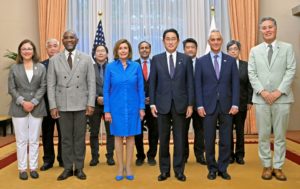
Figure 5 Japanese Prime Minister Kishida Fumio poses for a picture with US House of Representatives Speaker Nancy Pelosi and members of her congressional delegation. Photo: Ministry of Foreign Affairs of Japan
The Pelosi visit ratcheted up tensions between the US and China, and yet the two powers were careful to communicate their intentions. To be sure, China was unhappy with the visit, the highest-ranking visit of a US elected representative to Taiwan in 25 years. The question remains, however, what the visit changed. Afterwards, delegation after delegation of US Congressional representatives visited Taiwan. Just prior to Pelosi’s visit, Japanese Diet members, including former Minister of Defense Ishiba Shigeru and Hamada Yasukazu (who later became minister of defense in the August 10 Cabinet reshuffle), had also made a point of demonstrating their interest in and support for Taiwan.
After a visit to South Korea, Pelosi’s delegation ended their Asia tour in Tokyo, where they met with Prime Minister Kishida and Japan’s House of Representatives Speaker Hosoda Hiroyuki.
Conclusion
Domestic politics remain tricky for both Kishida and Biden. By the end of the summer, Kishida’s support rating had dipped 16 points to 36% according to Mainichi Shimbun. Kishida’s July electoral win has been overshadowed by these political tensions, but he has time to recover public confidence before the next election, which is likely years away. Biden, in contrast, has the midterm elections ahead of him this November. Biden’s support rating rebounded 5 points to 43% at the end of the summer after hitting a low of 38% in July. Inflation will likely be the defining factor in the upcoming Congressional election, but the Supreme Court decisions on gun control and abortion have complicated predictions for a straight-up win in the US legislature for the Republican opposition. This makes for an uneasy fall as midterms approach.
The Russian war in Ukraine continues with widespread global consequences. The United States and Japan remain closely coordinated in their responses and the G7 has emerged as the primary vehicle for policy coordination with Europe. The Biden administration continues to offer lethal assistance to Ukraine, while Japan focuses on nonlethal aid. Over the summer, Washington and Tokyo had ample opportunity to align their global diplomacy to define this war as a violation of international norms and a challenge to the “rules-based order.” NATO allies invited their Indo-Pacific allies to join them at the Madrid Summit, producing yet another venue for demonstrating shared purpose vis-à-vis Russia. This winter’s fuel and food crisis looms, however, and Japan and the United States will need to do more to mitigate the adverse impact of these scarcities on Europe’s economies as well as on the world’s poorer nations.
The US-Japan alliance continues to adapt to rising tensions across the Taiwan Strait. More than anything, the prospect of a military conflict there will shape Tokyo and Washington’s agenda. Kishida and his Cabinet continue Japan’s strategic review, and by the end of 2022, Kishida’s much anticipated promise of considerably larger defense spending and a decision on retaliatory counterstrike capability will be revealed. The United States, too, will seek to ensure that it has the requisite capabilities forward deployed in the region to deter Chinese aggression. Both the United States and Japan will also continue to prepare for the economic disruptions that could result should Indo-Pacific tensions increase.
May 3, 2022: Former Defense Minister Onodera Itsunori and LDP Foreign Affairs Chief Sato Masahisa present the conclusions of the LDP’s strategic review at CSIS.
May 4, 2022: Defense Minister Kishi and Secretary of Defense Austin meet in Washington, DC.
May 4, 2022: Secretary of State Blinken and National Security Advisor Akiba Takeo meet in Washington, DC.
May 6, 2022: The vice-ministerial meeting of the US-Japan Economic Policy Consultative Committee (“Economic 2+2”) is held in Washington, DC.
May 9, 2022: G7 Foreign Ministers release a joint statement on the Hong Kong Chief Executive selection.
May 9, 2022: Governor of Hawaii David Ige and Speaker Scott Saiki of the Hawaii House of Representatives meet with Prime Minister Kishida in Tokyo.
May 11, 2022: Japan’s Upper House passes a new law promoting economic security.
May 23, 2022: President Biden and Prime Minister Kishida meet in Tokyo. Joint Statement.
May 23, 2022: Secretary of State Blinken and Minister for Foreign Affairs Hayashi Yoshimasa meet in Tokyo.
May 24, 2022: Prime Minister Kishida, President Biden, Australian Prime Minister Anthony Albanese, and Indian Prime Minister Narendra Modi hold Quad Leaders’ Summit in Tokyo. Joint Statement.
May 25, 2022: Deputy Secretary of State Wendy Sherman, Vice Foreign Minister Mori Takeo, and Korean First Vice Foreign Minister Cho Hyun-dong speak by telephone.
May 25, 2022: Secretary of State Blinken and Foreign Minister Hayashi speak by telephone.
June 1, 2022: US-Japan Southeast Asia Policy Dialogue is held via videoconference.
June 2, 2022: US Congressional Study Group on Japan meets Prime Minister Kishida in Tokyo.
June 3, 2022: Special Representative for the DPRK Sung Kim, Director General for Asian and Oceanian Affairs Funakoshi Takehiro, and Korean Special Representative for Korean Peninsula Peace and Security Affairs Kim Gunn meetin Seoul.
June 8, 2022: Vice Minister for Foreign Affairs Mori Takeo, Deputy Secretary of State Sherman, and Korean First Vice Minister Cho Hyundong hold a Japan-US-Korea Trilateral Vice Foreign Ministerial Meeting in Seoul. Joint Statement.
June 8, 2022: Vice Minister for Foreign Affairs Takeo and Deputy Secretary of State Sherman hold Vice Ministers’ Meeting on sidelines of Japan-US-ROK Vice Ministers’ Meeting in Seoul.
June 11, 2022: Secretary of Defense Lloyd Austin, Minister of Defense Kishi Nobuo, and Korean Minister of National Defense Lee Jong-sup hold a Trilateral Ministerial Meeting in Singapore.
June 21-22, 2022: Japan-US Extended Deterrence Dialogue is held at King’s Bay Naval Base in Georgia.
June 27, 2022: President Biden and Prime Minister Kishida meet on the sidelines of the G7 Elmau Summit in Germany.
July 8, 2022: Special Representative for the DPRK Sung Kim, Director General for Asian and Oceanian Affairs Funakoshi, and Korean Special Representative for Korean Peninsula Peace and Security Affairs Kim Gunn meet to discuss trilateral cooperation on North Korea.
July 8, 2022: Former Japanese Prime Minister Abe Shinzo is assassinated.
July 8, 2022: Secretary of State Blinken, Foreign Minister Hayashi, and Korean Foreign Minister Park Jin meet in Bali, Indonesia.
July 9, 2022: Prime Minister Kishida and President Biden speak by telephone.
July 10, 2022: Japan holds an election for the Upper House.
July 11, 2022: Secretary of State Blinken and Prime Minister Kishida meet in Tokyo.
July 14, 2022: Assistant Secretary of State for East Asian and Pacific Affairs Daniel Kritenbrink and Director-General of the North American Affairs Bureau Ichikawa Keiichi meet in Tokyo.
July 19, 2022: Secretary of State Blinken and Foreign Minister Hayashi co-host virtual COVID-19 Global Action Plan (GAP) Foreign Ministerial Meeting.
July 25, 2022: Under Secretary of State for Political Affairs Victoria Nuland and Vice Minister for Foreign Affairs Mori Takeo meet in Tokyo.
July 25, 2022: Under Secretary of State for Political Affairs Nuland and Senior Deputy Foreign Minister Yamada Shigeo meet in Tokyo.
July 27, 2022: Japan-US Director-General Level Consultation on Africa is held via videoconference.
July 28, 2022: Foreign Minister Hayashi meets members of Congress for dinner during his trip to Washington, DC.
July 29, 2022: Foreign Minister Hayashi and Secretary of State Blinken meet in Washington, DC.
July 29, 2022: Foreign Minister Hayashi gives a speech at the Center for Strategic & International Studies during his trip to Washington, DC.
July 29, 2022: Secretary of State Blinken, Secretary of Commerce Gina Raimondo, Foreign Minister Hayashi, and METI Minister Hagiuda Koichi hold the first US-Japan Economic Policy Consultative Committee (“Economic 2+2”) in Washington, DC. Joint Statement.
Aug. 2-3, 2022: Speaker of the House of Representatives Nancy Pelosi leads delegation to Taiwan.
Aug. 3, 2022: Speaker Pelosi and Taiwanese President Tsai Ing-wen meet in Taipei.
Aug. 3, 2022: G7 Foreign Ministers release a joint statement on preserving peace and stability across the Taiwan Strait.
Aug. 3, 2022: The G7 Foreign Ministers release a joint statement on energy security.
Aug. 4, 2022: Defense Minister Kishi announces that five ballistic missiles fired by China landed in Japan’s exclusive economic zone.
Aug. 5, 2022: Speaker Pelosi and Prime Minister Kishida meet in Tokyo.
Aug. 5, 2022: Secretary of State Blinken, Foreign Minister Hayashi, and Australian Foreign Minister Penny Wong hold a US-Japan-Australia Trilateral Strategic Dialogue.
Aug. 9, 2022: President Biden signs the CHIPS and Science Act into law.
Aug. 10, 2022: Prime Minister Kishida reshuffles his Cabinet.
Aug. 31, 2022: Chairman of the US-Japan Business Council Douglas Peterson, a delegation from the US Chamber of Commerce, and Foreign Minister Hayashi meet in Tokyo.